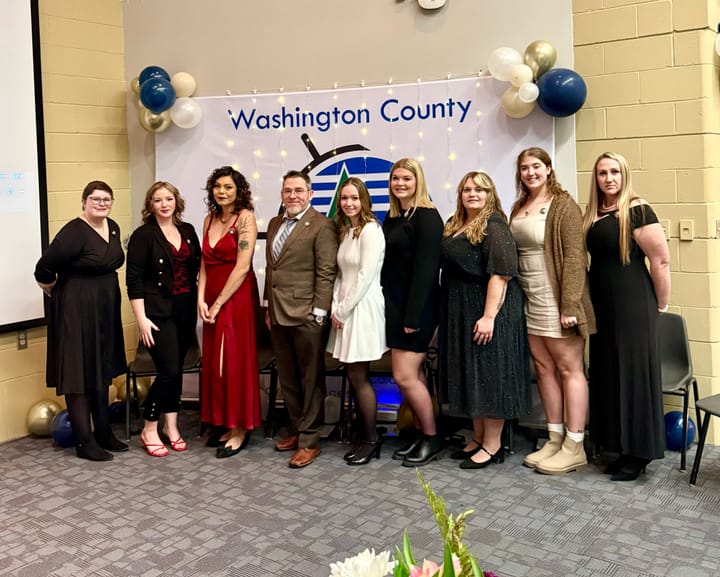New co-op to plan marketing strategy for selling scallops
A new marketing cooperative, focused on the marketing of Cobscook Bay scallops and agricultural products, is planned for downtown Eastport by the Cobscook Bay Resource Center, which recently acquired a building at the head of the breakwater.
A new marketing cooperative, focused on the marketing of Cobscook Bay scallops and agricultural products, is planned for downtown Eastport by the Cobscook Bay Resource Center, which recently acquired a building at the head of the breakwater. The building will also be used to house the new offices for the resource center.
The resource center obtained a $198,400 grant for developing the marketing co-op through the U.S. Department of Housing and Urban Development (HUD), with assistance from Senators Olympia Snowe and Susan Collins and Rep. Michael Michaud. The HUD funds will be used to build a new facility attached to the existing building. The resource center also will be conducting a capital campaign for renovating the existing building at 110 Water St., which was formerly used as a clothing shop and previously as a bakery. The renovated building will house a community meeting room, a library, a small retail area, research space and offices.
The marketing co-op will act as an incubator for the efforts of local people engaged in the production of both seafood and agricultural products. "We're trying to develop very focused niche markets," says Will Hopkins, executive director of the resource center. He says the co-op will not be a fishermen's co-op, which is usually made up of lobstermen and used for buying bait and selling lobsters. Instead, the co-op will focus primarily on helping fishermen identify and expand markets for Cobscook Bay scallops as a premium product, rather than as a low-cost commodity. The marketing effort will build on recent changes in management of the scallop resource that allow scallops to be harvested on a more sustainable basis, in smaller daily amounts suitable to the careful handling required for high-end product.
The marketing co-op will be working with local fishermen who would like to grade their catch so that, with better handling and packaging and an identifiable brand, they can receive a better price. A recent scallop market study found that there are places, such as certain restaurants, for marketing high quality scallops. Hopkins notes that Cobscook Bay has the last productive scallop beds in the state, and many people believe they are higher quality scallops. "If we promote Cobscook Bay scallops through the co-op, it also increases the value of Cobscook Bay scallops that another dealer is selling," says Hopkins. "People want fresh, properly handled seafood, and some people are willing to pay the price for it."
Chris Bartlett, chairman of the board for the resource center, comments, "I think it's a great opportunity to work with the Cobscook Bay Fishermen's Association and other fishermen to develop high-end markets for the scallop fishery and other fisheries in the area."
In addition, the resource center will also work to expand the sales of Cobscook scallops locally to residents and restaurants.
Also, the facility will be designed to accommodate other local food production enterprises, such as crabmeat picking in a HAACP (Hazard Analysis and Critical Control Point) certified workspace, and adding value to local farm produce in a modest community kitchen. Hopkins notes that, in order to meet the new HAACP regulations, some people can no longer pick crabmeat in their homes. The community kitchen could be used by people for putting up jams, pickles or preserves in a certified place.
The marketing co-op probably would not be handling seafood such as lobsters, urchins, clams or mussels, as there are already a good number of dealers for those products. "Our intent is not to get into competition with existing businesses," says Hopkins. "We want to focus on opportunities that haven't been developed in the past."
The resource center hopes to complete the planning and design phase this winter and begin construction in summer 2006. Co-op operations are targeted to begin by the opening of scallop season on December 1, 2006.
"We're just at the beginning of looking at what we will do," stresses Hopkins. "Now it's time to really start looking at equipment and space and regulatory requirements for each one of these possibilities. We have a long way to go before we have completed plans or all the money to pay for it."
In its new office location, the resource center will continue to provide a community meeting room for hosting fishermen's meetings, Department of Marine Resources representatives and researchers. It will also continue with its environmental monitoring for water quality, research projects and technical assistance to fishermen.
Hopkins notes, "We were at 183 County Road for six years, and the office was sold out from under us. We had the opportunity to purchase it, and our bid was not accepted." Although that opportunity was lost, Hopkins is pleased with the new location, noting that the County Road location as too far from the center of activities. "We think the head of the breakwater is the best location we can get."

